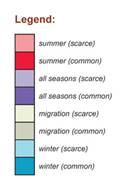“Warbles and trills and solo after solo … the air was magically busy. None of us spoke while the songs of the birds poured undiluted. I suppose we were afraid the spate of loveliest sound would vanish if we broke it with so much as a whisper. But after a bit came the realization that the music of birds formed a natural part of this place, constant as the glorious grass that made feathered life thrive.” Ride with me Mariah Montana, Ivan Doig.
Western meadowlarks are open country birds and once you hear them start singing you know spring is around the corner. Spring
They can be found in grasslands, shrub-steppe, and agricultural areas. Here in Washington they are primarily found east of the Cascade Mountains but can be found in limited areas on the west side where there is suitable habitat. They are about 8.5 inches long and weigh 3.5 ounces. It is the state bird of Montana, Kansas, Nebraska, North Dakota, Oregon, and Wyoming. They occupy habitat from close to sea level up to 9,000 ft.


Meadowlarks are in the blackbird family but look distinctively different from most of their relatives – and not a lark. They have a streaked brown upperpart with a yellow underpart and a black collar. The yellow and the black are more vivid during the breeding season. They are a bit chubby looking and seem to furiously flap to stay in the air. When flying their outer white tail feathers are obvious. Sturnella, Latin for starling and neglecta –ignored or overlooked.
During the winter they group up in single-species flocks or with other blackbirds and starlings. The forage mostly on the ground, running or walking and probing around the soil with their bills. In the spring they are particularly noticeable on top of shrubs, fences, utility poles, or high structures in open country. During the summer most of their diet consists of insects and in the winter it is made up of seeds and waste grain. Occasionally they will prey on other nestlings and in the winter may scavenge carcasses.

Meadowlarks nest on the ground in small depressions under dense vegetation. Even when you see where the shrub where you suspect a nest it can take quite a while to actually find it. Meadowlarks are polygynous – the males mating with two females during the season. The females build the nest, which is a grass dome with side entrances. The nest material is interwoven with the adjacent shrub and small trails may lead from the adjacent grass cover to the nest. Females will incubate 4-6 eggs for 13 or 14 days.

Most of the work of raising the young is left to the female though males occasionally may assist. After 10-12 days the young leave the nest – they can’t yet fly but are pretty good runners. Their color scheme is cryptic, which helps them avoid predators. Predators of meadowlarks include raccoons, other small mammals, snakes, ravens, and birds of prey, among others. Brown-headed cowbirds may affect their nesting success by laying their own eggs in the meadowlark nest and destroying the meadowlark eggs.
Coming back from Bend, Oregon this past weekend we stopped near Selah Canyon to eat lunch at a highway rest stop. We parked ourselves on the bench/table and were munching away – it was sunny but windy and cool. Then I heard it over the wind and tilted my head around. There it was – the first meadowlark of the season, sitting on top of some sagebrush on the nearby hillside. I couldn’t find it without binoculars but that distinctive flute-like call guaranteed that warmer days were on the way.
